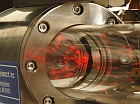New CO2 Tracker on Jungfraujoch
The Jungfraujoch hosts a new laser system to discern the level ofhuman activity on greenhouse gasses.

|
Caption: Measuring chamber: The gas sample to be evaluated is introduced continuously (up to 10 liters/minute) and is measured through the absorption of the laser beam (visible in red on this image). |
|||
|
Transportable apparatus allows for continuous ‘real-time’ measurement: |
|||
|
|
|||
|
Assembly and adjustment of the optical system. |
||
|
|
|||
|
Jungfrau unique: |
|||
|
|
|||
|
The laser beam must be guided towards the measuring chamber, and then the signal is turned towards the detector. |
||
|
|
|||
|
Discerns isotopic signatures: Fortunately, nature provides us with a valuable, although relatively enigmatic tool: the isotopic signature. Depending on its origin, the isotopic composition of CO2 is slightly altered. Plants and bacteria are able to "filter" certain isotopes of carbon or oxygen in CO2 during photosynthesis or respiration. This "selection" is also found in oil and other fossil fuels and therefore in the CO2 produced in burning these fuels. The instrument developed by Lukas Emmenegger’s group of researchers at Empa jointly with a commercial partner in the U.S. (Aerodyne Research), is capable of measuring this minute difference. Since 2007, five units have already been sold by Aerodyne research. The Empa team is also maintaining a close collaboration with Professor Leuenberger of the University of Bern who has been analyzing the isotopic composition of individual samples of CO2 at Jungfraujoch for several years. The project was supported financially by the National Centre of Competence in Research - Quantum Photonics, Alpes Lasers SA, and the Federal Office of Environment (FOEN). |
|||
|
|||
|
|||
|
|||



